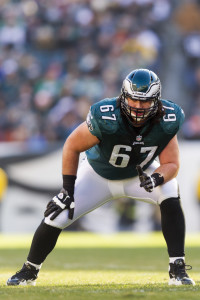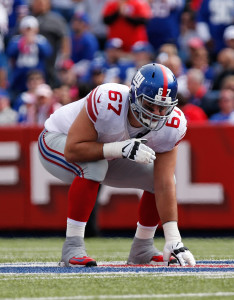The 2016 NFL draft is less than 48 hours away, and teams are looking for players capable of improving the long-term outlook of the franchise, while fans hope their favorite team’s next draft pick will be the star who brings the city one step closer to the postseason, or even a Super Bowl.
A handful of names have dominated the conversation in recent weeks, with most mock drafts (including ours) focusing on the first round. Over the next two days, we’ll take a closer look at several more day-two and day-three names, identifying the top 15 prospects at each position in the 2016 draft class.
We’ll almost certainly be higher or lower on some prospects than you are, so feel free to weigh in below in our comments section to let us know which players we’ve got wrong.
The big debate starts at the top, where
Jared Goff and
Carson Wentz have vied to be the first quarterback taken. Goff has the numbers and experience, as a three-year starter at California where he played in a pass heavy offense. He started out shakily, going 1-11 as a true freshman, but over his last two years he threw for nearly 8,700 combined yards and 78 touchdowns. Goff’s particular strengths come from his ability to work in a crowded pocket and deliver the football from unorthodox angles. While some observers point to the lack of consistency in his mechanics, a lot of that stems from being forced to throw on the move or off his back foot. That could get him into trouble – as it did during his five-interception outing against Utah – but it wasn’t a problem during the few clean pockets he got at Cal.
Wentz shot up draft boards and wowed scouts and analysts first with his size and athleticism, as well as his big-time arm. It was at the Senior Bowl where his stock rose most dramatically, showing off a lot of talent for an FCS prospect. Wentz’s biggest question mark is the talent level he faced at North Dakota State, but his supporters will say he maximized his opportunities by winning two championships in two years as a starter. Additionally, he only has 23 starts under his belt after missing a portion of his redshirt senior season with a wrist injury, making him a difficult evaluation based on a lack of tape alone. Neither he nor Goff is considered “NFL-ready” – which is often a case of analysts covering their you-know-whats in case they bust out – but Wentz particularly is thought of as needing some time to catch up to the speed of NFL defenses.
There seems to be no real consensus on which of the top two QBs should be ranked higher, but based on what the Rams gave up to get to the top, the reports that they are leaning towards Goff are backed up by the idea that at the very least he has more tools to be successful as a Week 1 starter in 2016.
The third quarterback on most boards is Paxton Lynch, a 6’7″ kid with a huge arm and mobility, although Connor Cook and Christian Hackenberg haven’t completely conceded their claims to that No. 3 spot. Lynch showed tremendous potential for Memphis, where he completed a ridiculous 67% of his passes as a senior while still going for 8.5 yards per attempt. Of course, that was accomplished on a ton of screen passes and short throws, staples of the Memphis offense. Lynch’s average depth of target was significantly lower than that of his peers in this draft class, and despite clocking in at the NFL combine with the most velocity on his arm, he rarely used that throwing power to launch the ball deep down the field. Wherever he ends up in the NFL, it will be imperative that he threatens every part of the field, and that will mean going vertical.
After Lynch come the two biggest disappointments of this class, in Cook and Hackenberg. Each was hoping to be in the mix a for top-five selection, but neither fulfilled that promise during their 2015 campaigns. In addition to their inconsistent performances, both have been questioned as leaders. Cook, who had a few missteps with the media during the season, was a senior quarterback who wasn’t voted captain by his teammates. Hackenberg, meanwhile, reportedly shifted the blame for his up-and-down performance to poor offensive line play and sub-par receivers, and maybe even questioned his coaching staff during pre-draft interviews with NFL teams. Hackenberg’s chances of landing in the first round really dried up when the Texans made the huge offer to Brock Osweiler in free agency, while Cook still has an outside shot of a team trading into the back end of round one to get him.
Like Cook and Hackenberg, Cardale Jones was a disappointment in 2015, but his situation is different for two reasons. The first is that based only on a three-game sample, he was probably elevated into the first-round discussion prematurely after winning a National Championship last season. Taking into account how he struggled to match that production before ultimately losing the starting job to J.T. Barrett, he’s left without a meaningful sample of overall games as well. Cook’s junior season and Hackenberg’s freshman year are enough to prove to teams they can still be fixed, but Jones doesn’t have much to point to other than his three-game postseason run. For that reason, he probably peaks as a third-round selection, but is more likely to hear his name called on the third day.
While those three players slipped down draft boards, there are two guys who have shot up a little and at least put themselves in the conversation to be the fourth quarterback selected. Dak Prescott had a sensational career at Mississippi State, but his senior year was the first time he was ever thought of as an NFL prospect. He worked on his mechanics, and adopted a more NFL-friendly style by relying less on his physical gifts – both his arms and his legs – and more on his ability to read and manipulate defenses. He likely would have been considered a candidate to sign as an undrafted free agent, but morphed himself into a legitimate pick in rounds three or four. He may have even held second-round upside if not for his DUI arrest during the pre-draft process, which likely took him off some teams’ boards or at least hurt his stock in war rooms.
Kevin Hogan is the other quarterback who did a lot to help himself as a senior and throughout the pre-draft process. Also viewed as a very late pick or an undrafted free agent, Hogan worked on his decision making and posted his best personal season. He completed close to 68% of his passes while maintaining an average yards per attempt of 9.4 and leading Stanford to a 12-2 record and a blowout victory in the Rose Bowl. His throwing motion is still far too long and his physical skills limit his ceiling, but he deserves credit for the improvements he made to make himself a very draftable player — he’s probably now considered a solid backup with upside.
After Hogan there will be a mixed bag, with some scouts and analysts viewing Brandon Allen, Nate Sudfeld, and/or Brandon Doughty in the same light as the Stanford quarterback, as backups with upside. Even Cody Kessler could get some love in that regard, even though he probably doesn’t have the physical tools to keep up with the rest of the bunch when being picked apart by scouts. Jacoby Brissett and Jeff Driskel have some athleticism and playmaking abilities that could make them intriguing, and you could throw Trevone Boykin in that mix as well even if his NFL combine numbers don’t dictate that athlete we see on film.
Running Back:
- Ezekiel Elliott (Ohio State)
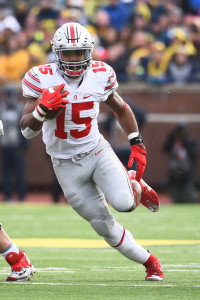
- Derrick Henry (Alabama)
- Jordan Howard (Indiana)
- Alex Collins (Arkansas)
- Paul Perkins (UCLA)
- C.J. Prosise (Notre Dame)
- Keith Marshall (Georgia)
- Kenyan Drake (Alabama)
- Kenneth Dixon (Louisiana Tech)
- Jonathan Williams (Arkansas)
- Devontae Booker (Utah)
- D.J. Foster (Arizona State)
- Kelvin Taylor (Florida)
- Byron Marshall (Oregon)
- Kareem Hunt (Toledo)
The conversation at running back is really a conversation about Ezekiel Elliott and how running backs are valued. Last season, both Todd Gurley and Melvin Gordon were first-round picks, but only Gurley had a rookie season worth mentioning. Even his campaign was buoyed by some big runs, rather than consistent production. Few put Elliott in Gurley’s class as a physical specimen, but where he does shine is as an all-around back. That’s not meant to downplay the fact that he amassed 1,800 yards as a rusher in each of his two seasons as a starter, including an unforgettable annihilation of Wisconsin, Alabama, and Oregon in successive postseason games. Still, scouts get more excited about evaluating him as a pass protector, and are quick to point out that he is an extremely capable receiving option out of the backfield.
Of course, that same evaluation could have been written for Trent Richardson back in 2012. That’s where the breakdown between evaluation and positional value occurs. Will defying mainstream thinking about first-round running backs net you a world beater like Gurley, or put you on the hot seat like Richardson did? Even the Chargers’ selection of Gordon looks questionable, with running backs available in later rounds and plenty of talent at other positions passed on to take a first-round back. Elliott is as good as they come, but the ghost of Richardson haunts that position more than any other bust looms in NFL draft circles.
After Elliott, there’s a glut of players that will likely be day two picks. Boards will be all over the place on them, but the most interesting name is Derrick Henry. The Heisman Trophy winner had 395 carries for 2,219 yards and 28 touchdowns as a junior, leading the nation in each of those categories. At 6’3″ and 240-plus pounds he is bigger than any modern running back in memory other than Brandon Jacobs, but his 40-time puts him in the same speed category as much smaller backs and receivers, as well as basically anyone his size. However, he needs momentum to get to that speed, and he doesn’t move well laterally behind the line of scrimmage. There’s some concern that Henry’s physical dominance will be diminished at the NFL level and he could bust out like Richardson, another former Crimson Tide back. Yet, with a good offensive line and his unique skill set, he might be able to take advantage of linebackers and safeties at the second level, who have skewed smaller in recent years with a bigger focus on speed and coverage skills.
Jordan Howard doesn’t bring the same size as Henry, but he has earned plenty of draft love for his similar power running style. He has a frame more common for a running back, and in that way brings less risk. He only played nine games at Indiana this past season, but was a productive runner with 1,200 yards and nine touchdowns, averaging more than six yards per carry. Before that he was a standout at UAB, where he put up big numbers before transferring.
Alex Collins is the other big name with a chance to be a true feature back. He had three extremely productive seasons at Arkansas, rushing for more than 1,000 yards in each and totaling more than 3,700 yards and 36 touchdowns for his career. His teammate Jonathan Williams missed the 2015 season, but played extremely well in 2013 and 2014, totaling 2,000+ yards and 16 touchdowns — Williams’ numbers were nearly identical to Collins’, but he averaged more yards per carry as the power back for the Razorbacks.
Utah’s Devontae Booker would probably be in a similar position as those two Arkansas prospects if injury concerns hadn’t seriously decreased his stock. He was just as productive while also impacting the game as a receiver for the Utes.
Speaking of receiving threats, Paul Perkins, C.J. Prosise, Kenyan Drake, and Kenneth Dixon all fit the mold of a third-down back who could catch plenty of passes out of the backfield and become a matchup problem for linebackers trying to cover them in the slot. Of that group, Perkins and Dixon are the most traditional running backs, carrying the load for their teams during their collegiate careers. Perkins had 2,800 yards in the past two seasons with 23 rushing touchdowns, while Dixon was an impact player for four years, narrowly missing the 1,000 yard mark as a sophomore, which would have made him the rare runner to hit that mark in all four collegiate seasons. He totaled 87 touchdowns rushing and receiving for his career.
Drake was Henry’s backup, but showed he had the explosiveness to make big plays as a runner and receiver when given the chance, and was also an excellent returner for the Crimson Tide as a senior. Prosise is even more interesting, as a converted receiver who held his own in the backfield. He represents the player with the most upside in the Dion Lewis or Danny Woodhead role in the NFL. Arizona State’s D.J. Foster could also carve out a similar role, after finishing an excellent career at multiple positions in college.
Running back seems to be deep with specialty players who can contribute, even if the amount of all-around backs who can carry the load are far and few between. Kelvin Taylor and Kareem Hunt provide some upside for teams looking to draft a runner in the later rounds, as does Byron Marshall. Keith Marshall might be the most intriguing late-rounder, as a highly recruited player who was forced to sit behind Gurley and then Nick Chubb while struggling with injuries and was never able to reclaim his role. A blazing fast 40-yard dash and elite physical skills make him a high-reward player who could leapfrog more productive players ahead of him.
While all of these players have something to offer, Elliott is so sought after because he doesn’t need to be paired with another back. He fits all schemes, and he isn’t going to be brought in as a third-down back or a complementary piece. The team that drafts him will expect a player that can carry the ball 250 times a season, and one who will help their quarterback in a variety of ways. Although selecting a running back in the first round has become a controversial decision, Elliott plays the position differently from the rest of the runners available in this class.
Wide Receiver:
- Josh Doctson (TCU)
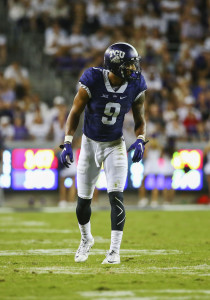
- Laquon Treadwell (Ole Miss)
- Michael Thomas (Ohio State)
- Corey Coleman (Baylor)
- William Fuller (Notre Dame)
- Sterling Shepard (Oklahoma)
- Tyler Boyd (Pittsburgh)
- Pharoh Cooper (South Carolina)
- Braxton Miller (Ohio State)
- Leonte Carroo (Rutgers)
- Malcolm Mitchell (Georgia)
- Demarcus Robinson (Florida)
- Michael Thomas (Southern Miss)
- Aaron Burbridge (Michigan State)
- Rashard Higgins (Colorado State)
The last time no wide receiver was selected within the top 10 picks of an NFL draft was back in 2010, when Demaryius Thomas and Dez Bryant went 22nd and 24th, respectively. After two great classes of prospects at the position, the wideouts take a step back in 2016 without any expected to come off the board in the first 15 picks.
Although the class lacks a true can’t-miss player such as Sammy Watkins or Amari Cooper, another factor in the group’s collective draft stock falling involves having so many players with different skill sets and no clear top player at the position. Laquon Treadwell was leading the pack most of the way, but questions about his speed and athleticism have him trending in the wrong direction come draft day. Part of that comes from a slow 40-time relative to the rest of the group, but he’s also just not the guy who runs downfield and gets open. Instead, his strength is going up and attacking the ball when he’s covered.
As a receiver, Treadwell doesn’t resemble a similarly-rated player like Corey Coleman. The Baylor speedster didn’t have a lot of experience with a full route tree, but showed off blazing speed and the ability to be dangerous after the catch. The difference between when one gets drafted as opposed to the other will largely depend on what skills a team values at the position. Treadwell might not be such a great match as a complement to DeAndre Hopkins in Houston, but he would fit nicely in Detroit or Minnesota.
Meanwhile, Michael Thomas and Josh Doctson are both tall receivers – though Doctson is a little more slender – and both are likely considered the top receiver in the draft by at least a few teams. Thomas has the physical tools to be that big, strong receiver without sacrificing pure straight-line speed in the process, but he doesn’t have the history of production as just one cog of a loaded Ohio State offense. Doctson, on the other hand, was a touchdown machine at TCU, scoring 25 over his last 23 collegiate games. As a senior, he played in 10 games before a wrist injury cost him the remainder of the season, but he still caught 78 passes for 1,326 yards and 14 touchdowns. Doctson is a little older, which knocks him down on some boards.
Those four guys are generally the high-upside secondary receivers with the potential to be the primary targets in NFL offenses, but after that there are still several intriguing options that teams will likely target into round two. On tape, William Fuller looks like the fastest receiver you’ve ever seen, and when he ran a 4.32 at the NFL combine, he confirmed that he has an elite skill that should translate to the NFL. Sterling Shepard is a more all-around type of secondary player — a tough-as-nails slot receiver who has surprising speed for his playing style. Shepard doesn’t have quite the explosive physical traits that Coleman does, but he has the ability to make a lot of plays in different areas of the field. Pharoh Cooper and Tyler Boyd are the next step down, but carried their respective offenses.
Leonte Carroo and Malcolm Mitchell are a little more underrated, as they are more like the all-around number one guys but without the athleticism to be dominant NFL players. They get forgotten because no one can imagine them being the next Odell Beckham (which is unfair, because no one thought Odell Beckham was going to be Odell Beckham). Braxton Miller has more name value as a former Heisman Trophy finalist as a quarterback, and he does have the size and speed that excites casual fans.
This class of receivers may not produce an all-world player, but it makes up for it by providing a glut of tier-two talents that could be in play late in the first round, or early in the second. There should also be plenty of depth to be found even on the third day of the draft.
Tight End/Fullback:
- Hunter Henry (Arkansas)
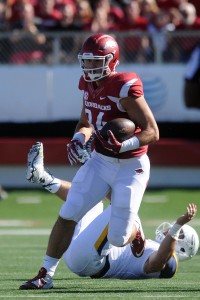
- Jerell Adams (South Carolina)
- Austin Hooper (Stanford)
- Nick Vannett (Ohio State)
- Glenn Gronkowski (Kansas State)
- Jake McGee (Florida)
- Tyler Higbee (Western Kentucky)
- Devon Cajuste (Stanford)
- Bryce Williams (East Carolina)
- Beau Sandland (Montana State)
- Andy Janovich (Nebraska)
- Dan Vitale (Northwestern)
- Derek Watt (Wisconsin)
- Thomas Duarte (UCLA)
- Laquan McGowan (Baylor)
Hopefully the depth at wide receiver makes up for the lack of reliable pass catchers in this group of tight ends and fullbacks. Hunter Henry is the consensus top player available, and some scouts and analysts have suggested that he is worthy of first-round consideration. His production wasn’t insignificant at Arkansas, where he caught 51 passes for 739 yards and three touchdowns as a junior, but those aren’t the awe-inspiring numbers that mark a game-changing offensive talent. Henry is noted for his balance, as he is able to stay on the field both as an in-line blocker as well as in obvious passing situations, where he’s athletic enough to flex out to the slot as a receiving option.
Henry may be a little boring in terms of what is expected from him, but reliability shouldn’t be overlooked from the tight end position. Jerell Adams is the other side of the spectrum. Originally thought of as a blocking tight end, he exhibited tremendous speed at the combine, where he ran a 4.64 40-yard dash. Adams isn’t a polished route runner, and while he may not have been a drop machine, his hands have been called into question. He showed a penchant for making spectacular plays at South Carolina, but his lack of production was concerning. Over his final two collegiate seasons, Adams totaled only 49 catches and four touchdowns.
Nick Vannett and Austin Hooper are viewed as the next two players at the position by most observers, even though Tyler Higbee had some fans prior to his recent off-the-field issues. Vannett is the old-school tight end, a big blocker with reliable hands. He only caught 19 passes in each of his last two seasons at Ohio State, but head coach Urban Meyer has publicly stated that he regrets not finding a way to get him the ball on a more consistent basis. There were a lot of mouths to feed on that offense, and only so much ball to go around, especially with the struggles at quarterback. Hooper was more of a receiving threat at Stanford, but without the blocking ability. A big knock on him despite his production was how many catchable balls he dropped in college, making him a frustrating weapon in the passing game.
Jake McGee and Devon Cajuste have a little bit more upside. McGee’s production at Virginia and then Florida won’t blow anyone away, but he was very reliable and gained a reputation for being able to make catches and exploit matchups from the tight end position. Cajuste was a receiver at Stanford, but his size (6’4″ and nearly 230 pounds) could allow him to transition into the sort of modern pass-catching tight end and red-zone threat quarterbacks dream of having on their roster. Since he’s never been asked to block in line, it’s impossible to project how Cajuste will fare in the trenches, but a willingness to do so will go a long way toward getting him on the field to be able to exploit his talents. He could also be selected on the third day as a wide receiver, but his value increases if he can convince a team he can play tight end.
With the fullback position being used more rarely, there aren’t a ton of open roster spots that will be committed to those players. Glenn Gronkowski, Andy Janovich, Dan Vitale, and Derek Watt have all made the case that they are draftable players with the ability to open up holes for running backs. Of that group, Gronkowski carries additional value on the field – despite not being the best pure fullback – because he has worked out in tight end drills, showing that he has the ability to play in multiple positions and schemes, and can at least be a credible threat in the passing game. Some teams may bump him up the board because of the pedigree of his last name, while other teams could downgrade him because of the headaches that could come along with being Rob’s brother.
Laquan McGowan is notable because he is a 6’7″, 410-plus pound tight end. He was a backup for Baylor, catching two passes in 2015 for the Bears. Both of those went for touchdowns, to his credit, but he has a slim chance of making an NFL roster in a traditional role. Still, McGowan hasn’t been totally discounted, since a coach like Bill Belichick could find a way to use him in some unorthodox way. Otherwise, he may have to settle for pursuing his backup career choice of attempting to become a professional wrestler in the WWE.
Offensive Tackle:
- Laremy Tunsil (Ole Miss)
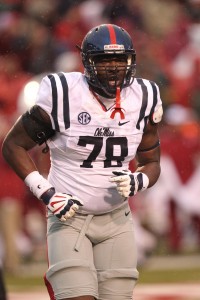
- Ronnie Stanley (Notre Dame)
- Jack Conklin (Michigan State)
- Taylor Decker (Ohio State)
- Shon Coleman (Auburn)
- Jason Spriggs (Indiana)
- Jerald Hawkins (LSU)
- Germain Ifedi (Texas A&M)
- Spencer Drango (Baylor)
- Kyle Murphy (Stanford)
- John Theus (Georgia)
- Le’Raven Clark (Texas Tech)
- Halapoulivaati Vaitai (TCU)
- Brandon Shell (South Carolina)
- Tyler Johnstone (Oregon)
Laremy Tunsil was long assumed to be the favorite to be selected first overall by the Titans. Of course, the Rams trading up to the top pick – almost certainly to take a quarterback – hurts his stock. If QBs are drafted first and second, as is expected, Tunsil finds himself with smaller paycheck as the third overall pick. If the Chargers don’t take him, then a bigger slide could occur, with some analysts envisioning a potential fall as far as 10 to the Giants.
All of that is unlikely, but it’s aided by off-the-field questions and a lack of game tape. While it may not impact his stock significantly, teams won’t forget that Tunsil was with Robert Nkemdiche the night that the Ole Miss defensive tackle cost himself possibly 40 spots in the draft. Also, because he served a suspension to start the season, Tunsil cost himself a lot of opportunities to put good film on the record. That’s a shame, because he has been compared athletically to Tyron Smith, who most would point to as one of if not the preeminent tackles in the NFL.
Not far behind him – according to most experts – is Ronnie Stanley, who has prototypical left tackle traits. He’s a gifted pass protector with quick feet and long arms who should be able to keep even NFL pass rushers off of the quarterback. He isn’t the most dominant run blocker and he did have trouble at times in college, especially with edge rushers who were particularly strong or fast, but Stanley has the balance and the frame to improve his strength and technique to combat those issues.
Rising up boards late in the process is Jack Conklin, the mauler out of Michigan State. He also has the long arms and tested well in terms of his athleticism, but he struggles with footwork and fails to use his length, leading to some questions about his ability to succeed at left tackle. Some envision right tackle as a more comfortable position for him, while his work in the run game dictates that guard could also be in play.
Taylor Decker spent a lot of time grouped in with that top three this season, but some scouts and analysts have soured on him as a franchise left tackle. He struggled in pass protection at times in 2015, and although he still has value as a physically gifted right tackle, most teams don’t address that position with a top-20 pick. He still could be in play when the Colts, Bills, and Jets come up to the podium but Conklin has surpassed him on most boards.
Shon Coleman is another one of the guys who draws mixed reviews. His inconsistency at Auburn was worrisome, but in his best games, he looked like a surefire first-round pick. Based on one game, his scouting report could read “polished pass blocker who struggles in the running game,” while scouting the next week could result in a report that reads “dominant in the run game with poor feet protecting the quarterback.”
The next group of players is filled with physically flawed prospects who could be solid swing tackles (Spencer Drango, Kyle Murphy, John Theus) and hyper-athletic offensive linemen who just haven’t seemed to put together any stretch of good tape (Jason Spriggs, Jerald Hawkins, Germain Ifedi, Le’Raven Clark). The former group has the higher floor while the latter obviously has the higher ceiling.
The evaluations on these players very much depend on the needs and the offensive line coach of the teams drafting them. A club looking for reliable backups with a chance to start down the road will target guys like Drango, who was a great pass protector at Baylor but has received criticism as a sub-par athlete. However, teams looking to find a franchise left tackle on the third day of the draft figure to look closely at Clark, who is far away from being a productive player but could be the next Terron Armstead for a lucky team that is able to develop him.
Interior Offensive Line (Guard/Center):
- Ryan Kelly (Alabama)
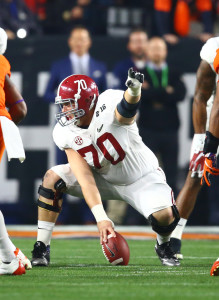
- Joshua Garnett (Stanford)
- Cody Whitehair (Kansas State)
- Landon Turner (UNC)
- Christian Westerman (Arizona State)
- Cole Toner (Harvard)
- Jack Allen (Michigan State)
- Nick Martin (Notre Dame)
- Mike Matthews (Texas A&M)
- Rees Odhiambo (Boise State)
- Vadal Alexander (LSU)
- Max Tuerk (USC)
- Sebastian Tretola (Arkansas)
- Evan Boehm (Missouri)
- Austin Blythe (Iowa)
Ryan Kelly stands out as the only first-rounder on the interior offensive line. The center from Alabama proved to be unbelievably reliable in the middle, controlling the offensive line and acting as a bully in the trenches. Watching tape on Derrick Henry, Kelly steals the show regularly. The offensive line doesn’t often get its due credit, but Henry’s Heisman Trophy was won because of the huge holes they were able to open up, and Kelly was the unquestioned star. Centers aren’t always considered to be valuable in the first round, but Kelly has a chance to be one of the best in the league at the position. The Jets don’t want their Nick Mangold pick back, and the Cowboys are happy with their selection of Travis Frederick. If Kelly lives up to his scouting report, no team will regret taking him either.
After Kelly, rankings may diverge significantly. They’re largely dependent on what teams are looking for in interior linemen, as well as in projecting what position many of these prospects will play at the next level.
Joshua Garnett is a traditional guard who was a staple at Stanford. He paved the way for a breakout season for Christian McCaffrey, who rushed for over 2,000 yards. He’s strong in the middle, and plays more athletic than his 5.32 40-yard dash would suggest. Landon Turner is another true guard, but his game is defined by power blocking inside. He was an old-school mauler for the Tar Heels on the inside, and a decorated player in the ACC. Zone-blocking schemes might not find any use for his talents though, as his 5.58 40-yard dash – which is the type of speed you see on film – was the worst of any player at the combine. Christian Westerman isn’t quite as highly regarded as either Garnett or Turner, but he moves very well for the position and should be a second-day selection.
For teams targeting more athletic guards, Cody Whitehair might be the preferred option. He played left tackle at Kansas State in 2015, and was a very good player for the Wildcats. His short arms are one of the major reasons he is being pushed inside, where they still won’t have ideal length. For his career, Whitehair has experience lining up across the offensive line, and could even be considered at center by some teams. Harvard’s Cole Toner is in a similar boat, with a little less upside than Whitehair athletically. He was a left tackle in college, but projects best as a guard or center at the next level. Vadal Alexander is another tackle looking to possibly shift inside, as he struggled with footwork in pass protection but is a huge, physically-imposing prospect at 6’6″ and around 330 pounds.
Jack Allen represents a very solid secondary option at center after Kelly — even though he’s undersized, he could succeed in zone-blocking schemes. Allen was highly regarded at Michigan State and performed well despite his 6’2″, 290-plus-pound frame. Nick Martin and Mike Matthews weren’t quite as good on film, but with older brothers coming out of Notre Dame and Texas A&M recently and having success as pros, they’ll likely be given the benefit of the doubt in their ability to translate to the NFL competition.
Centers and guards aren’t always interchangeable, but the group at the bottom – including Rees Odhiambo, Austin Blythe, Evan Boehm, Sebastian Tretola, and Max Tuerk – makes the class of interior offensive linemen pretty deep. Many of these players will hear their names called in the later rounds of the draft, but they’ll have a better chance than a day-three quarterback or pass rusher to make an impact on the field early in their respective careers.
Photos courtesy of USA Today Sports Images.
